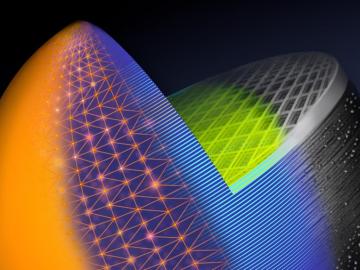
Filter News
Area of Research
News Type
News Topics
- (-) 3-D Printing/Advanced Manufacturing (47)
- (-) Advanced Reactors (9)
- (-) Clean Water (16)
- (-) Composites (9)
- (-) Cybersecurity (14)
- (-) Isotopes (32)
- (-) Space Exploration (12)
- Artificial Intelligence (52)
- Big Data (34)
- Bioenergy (52)
- Biology (62)
- Biomedical (33)
- Biotechnology (13)
- Buildings (28)
- Chemical Sciences (30)
- Climate Change (57)
- Computer Science (94)
- Coronavirus (18)
- Critical Materials (6)
- Decarbonization (51)
- Education (2)
- Emergency (2)
- Energy Storage (36)
- Environment (112)
- Exascale Computing (31)
- Fossil Energy (4)
- Frontier (28)
- Fusion (33)
- Grid (28)
- High-Performance Computing (49)
- Hydropower (5)
- ITER (2)
- Machine Learning (25)
- Materials (47)
- Materials Science (58)
- Mathematics (8)
- Mercury (7)
- Microelectronics (3)
- Microscopy (23)
- Molten Salt (1)
- Nanotechnology (20)
- National Security (50)
- Net Zero (8)
- Neutron Science (57)
- Nuclear Energy (61)
- Partnerships (21)
- Physics (36)
- Polymers (11)
- Quantum Computing (23)
- Quantum Science (33)
- Renewable Energy (1)
- Security (13)
- Simulation (35)
- Software (1)
- Statistics (1)
- Summit (33)
- Sustainable Energy (51)
- Transformational Challenge Reactor (3)
- Transportation (32)
Media Contacts

Participants in the SM2ART Research Experience for Undergraduates program got the chance to see what life is like in a research setting. REU participant Brianna Greer studied banana fibers as a reinforcing material in making lightweight parts for cars and bicycles.

Advanced materials research to enable energy-efficient, cost-competitive and environmentally friendly technologies for the United States and Japan is the goal of a memorandum of understanding, or MOU, between the Department of Energy’s Oak Ridge National Laboratory and Japan’s National Institute of Materials Science.

Researchers at ORNL have developed the first additive manufacturing slicing computer application to simultaneously speed and simplify digital conversion of accurate, large-format three-dimensional parts in a factory production setting.

Sara Martinez ensures the safety and longevity of aging structures at Oak Ridge National Laboratory, employing her engineering expertise to protect against natural disasters and extend the lifespan of critical facilities.

Researchers at ORNL and the University of Maine have designed and 3D-printed a single-piece, recyclable natural-material floor panel tested to be strong enough to replace construction materials like steel.

Early career scientist Frankie White's was part of two major isotope projects at the same time he was preparing to be a father. As co-lead on a team that achieved the first synthesis and characterization of a radium compound using single crystal X-ray diffraction and part of a team that characterized the properties of promethium, White reflects on the life-changing timeline at work, and at home.

Building innovations from ORNL will be on display in Washington, D.C. on the National Mall June 7 to June 9, 2024, during the U.S. Department of Housing and Urban Development’s Innovation Housing Showcase. For the first time, ORNL’s real-time building evaluator was demonstrated outside of a laboratory setting and deployed for building construction.

Momentum for manufacturing innovation in the United States got a boost during the inaugural MDF Innovation Days, held recently at the U.S. Department of Energy Manufacturing Demonstration Facility at Oak Ridge National Laboratory.

Researchers set a new benchmark for future experiments making materials in space rather than for space. They discovered that many kinds of glass have similar atomic structure and arrangements and can successfully be made in space. Scientists from nine institutions in government, academia and industry participated in this 5-year study.

Students from the first class of ORNL and Pellissippi State Community College's joint Chemical Radiation Technology Pathway toured isotope facilities at ORNL.


